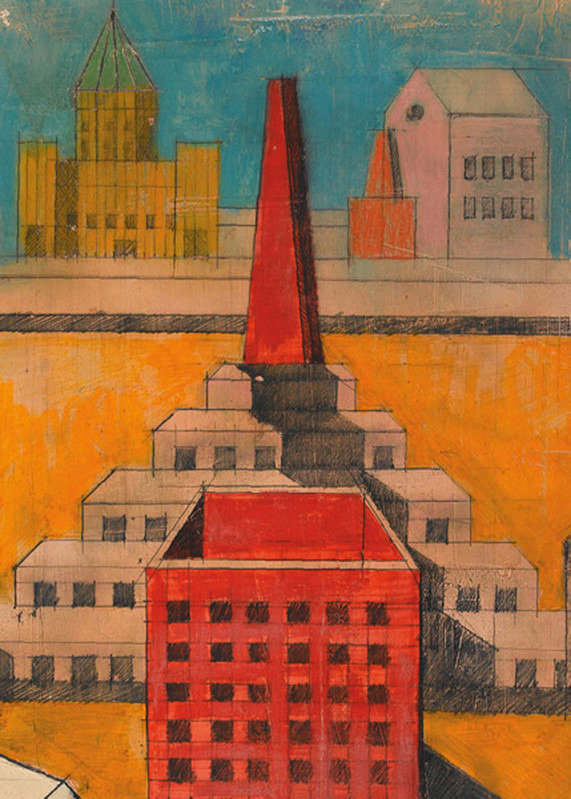La Tendenza
dal 19/6/2012 al 9/9/2012
Segnalato da
Mario Ridolfi
Alessandro Anselmi
Carlo Aymonino
Paolo Portoghesi
Ernesto Rogers
Aldo Rossi
Massimo Scolari
Salvatore Bisogni
Gianni Braghieri
Arduino Cantafora
G.R.A.U.
Edoardo Guazzoni
Antonio Monestiroli
Dario Passi
Franz Prati
Franco Purini
Uberto Siola
Franco Stella
Daniele Vitale
Giangiacomo D'Ardia
19/6/2012
La Tendenza
Centre Pompidou, Paris
Architectures italiennes 1965-1985. The exhibition traces the highlights of the movement led by Aldo Rossi, with 250 drawings, models, photographs, paintings and films, as well as a rich documentation. Rejecting the notions of avant-garde and Utopia to initiate a political and critical architecture tuned into reality, La Tendenza offers a new approach to the architectural project founded on a renewal of drawing and the image.

The Centre Pompidou is devoting an exhibition to La Tendenza, a pioneering international
architectural movement, led by Aldo Rossi, that came out of Italy in the post-war period.
The exhibition brings together a selection of major works from the Centre Pompidou’s
architecture collection, along with more than 250 drawings, historical models, photographs,
paintings, films, and a wide variety of documentary material.
Tendenza means ‘trend’, a form of progress that criticized the very idea of the avant-garde
as both idealistic and unrealistic. The movement rejected utopia in favour of a political and critical
architecture with a firm grip on reality.
This retrospective traces the beginnings of an architectural movement that questioned the
abstraction of modern architecture, advocating a return to historical forms, which would be known
as postmodernism.
Visitors will discover the works of the most famous architects of the Tendenza, such as Mario
Ridolfi, Alessandro Anselmi, Carlo Aymonino, Paolo Portoghesi, Ernesto N. Rogers, Aldo Rossi
and Massimo Scolari – and of other members of the movement who had a particularly strong
influence on the Italian scene: Salvatore Bisogni, Gianni Braghieri, Arduino Cantafora, the G.R.A.U
(Groupe Romain d’Architectes Urbanistes), Edoardo Guazzoni, Antonio Monestiroli, Dario Passi,
Franz Prati, Franco Purini, Uberto Siola, Franco Stella, Daniele Vitale, Giangiacomo D’Ardia et al.
La Tendenza would have major international repercussions, with Christian de Portzamparc
and Antoine Grumbach in France, Joseph Paul Kleihues, Oswald Mathias Ungers
(with whom Rem Koolhaas was trained) in Germany, Mario Botta and Fabio Reinhart in Switzerland,
the 2C group in Spain, and finally in the United States thanks to the publication of Aldo Rossi’s
writings by architect Peter Eisenman.
To accompany this exhibition, the Éditions du Centre Pompidou is publishing a 160-page catalogue
containing 200 illustrations, edited by Frédéric Migayrou, Deputy Director of the Musée national
d’art moderne / Centre de création industrielle.
In the period immediately after the war, Italian architects were working in a new context of crisis.
Some questioned the precepts of the modern movement and the cult of classical references of
the Fascist years. A realism akin to the neo-realism of Italian cinema asserted itself, one that required
a social commitment and a response to accelerated urban development, the construction of vast
suburban estates, and new social architecture programmes.
Under the aegis of Ernesto N. Rogers of B.B.P.R., the designers of Milan’s Tour Velasca (1950-1958),
the review Casabella-Continuità (with Ernesto Nathan Rogers and Vittorio Gregotti) initiated new debate
about the historical city. Urbanism asserted itself as a major discipline, particularly at the University
of Venice, where Giovanni Astengo and Giuseeppe Samonà trained a new generation of architects.
The experimental neighbourhoods of the INA-Casa, such as the Tiburtino neighbourhood in Rome,
designed by Ludovico Quaroni and Mario Ridolfi (1949-1954), provided an opportunity to put this urban
theory into practice. The architect Carlo Aymonino was involved in these projects early on, and was called
to the university in Venice by Giuseppe Samonà. In the 1960s, he was joined by the young Aldo Rossi;
together, they created a think tank, “Gruppo Architettura,” which sketched out a new project theory
founded on notions of architectural typologies and urban morphology.
The appearance of new, Marxist-influenced reviews such as Massimo Cacciari, Toni Negri, and Manfredo
Tafuri’s Contropiano, or Paolo Portoghesi and Massimo Scolari’s Controspazio opened up the debate
and began a rethinking of history that led to the creation of a movement. In Venice, Milan, Rome,
and Naples, a number of architects became involved in this search for a new architectural language,
a typo-morphology. It would come to be paid significant critical attention and lead to an intense period
of graphic production that translated this new architectural theory into images.
As the movement grew worldwide, galleries gave over their spaces to exhibitions of the group’s work:
first the 13th Milan Triennale in 1964, which was marked by the first student movements, then the
15th Milan Triennale in 1973, which was organized by Aldo Rossi and affirmed the presence of a new
rationalist architecture, Architettura Razionale. The 1978 Roma-Interrotta exhibition brought together
a group of young architects from both Italy and abroad who, in an innovative way, were drawing up plans
for a new Rome from those of the historical city. The exhibition anticipated two major events: the 1979
presentation of Aldo Rossi’s Teatro del Mondo, postmodern architecture floating on the Venetian Lagoon,
and the La Strada Novissima exhibition organized for the 1980 Venice Biennale by Paolo Portoghesi; the
latter toured to both France and the United States, thus affirming the presence of this historical school.
Image: Aldo Rossi, Perspective Composizione, Theatro del Mondo, Venezia, 1980 © Fondazione Aldo Rossi — Centre Pompidou — Musée national d’art moderne
Communications and
Partnerships Department:
Director
Françoise Pams
telephone
00 33 (0)1 44 78 12 87
e-mail
francoise.pams@centrepompidou.fr
press officer
Céline Janvier
telephone
00 33 (0)1 44 78 49 87
e-mail
celine.janvier@centrepompidou.fr
Centre Pompidou
75191 Paris cedex 04
Opening:
11am – 9pm every day, ex. Tuesdays and 1 May
Admission:
€11 - €13, depending on time
concessions €9 - €10
ticket valid the same day for the Musée national d’art moderne and all exhibitions
Free for under-18s and members of the Centre Pompidou



